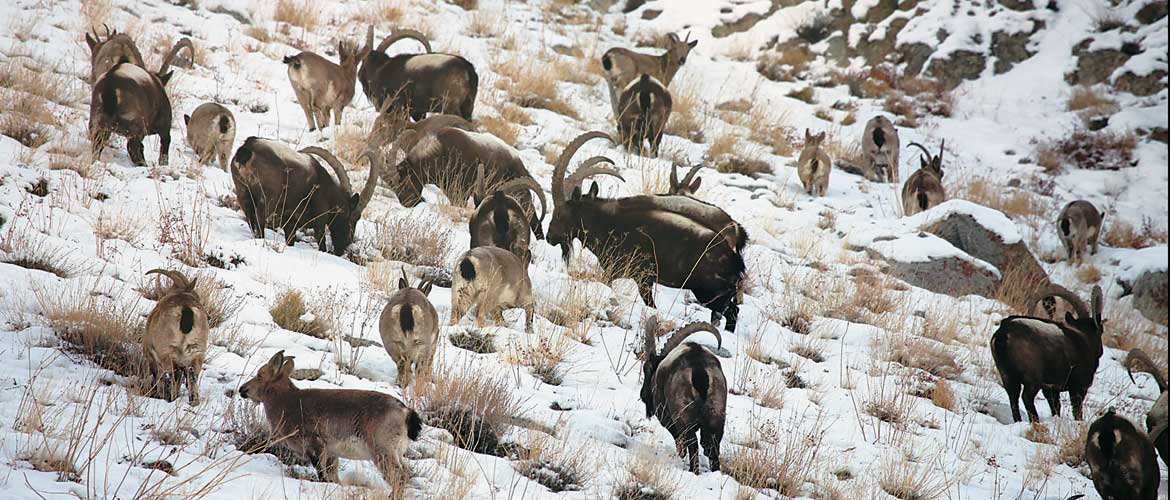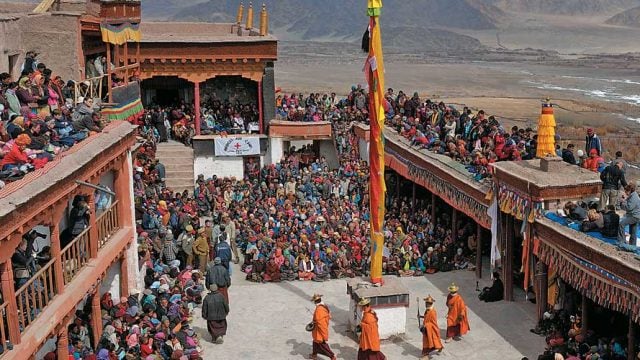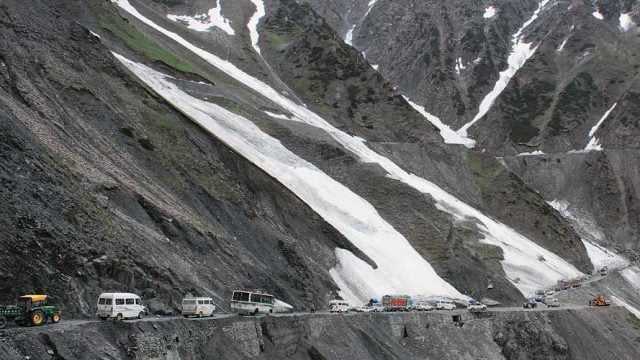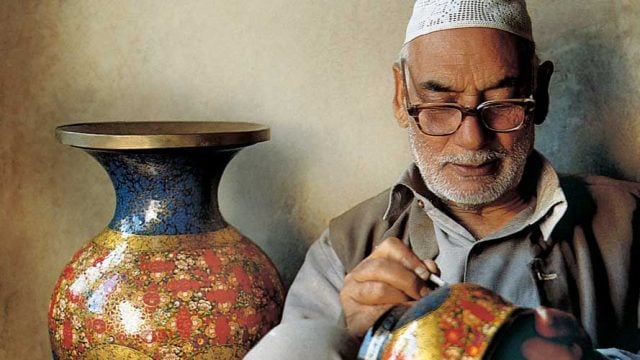Location The Hemis High-Altitude NP lies bepayond the west bank of the Indus River in
Distance The Martselang Gate of Hemis NP is 41 km SE of Leh; the Stok Gate 13 km S of Leh; the Zingchan Gate 25 km S of Leh; and the Chilling Gate 60 km SW of Leh
Route from Leh State highway to Karu via Choglamsar, Shey and Thiksey; state road to Martselang Gate of Hemis NP
This is peak season. All the trekkers must have driven out the wildlife,” said our travel agent, laughing. It was hardly an auspicious start to our visit. The best way to counter it, I decided, was by beginning my walk in the wild with blessings from the famous Hemis Gompa, after which the park is named. At the monastery, a young monk reassuringly informed me that the bharal, or blue sheep, made occasional visits to their doorstep. He then waved a fox tail in front of me with a flourish. “My friend found it in his village,” he said. That was the closest I would get to a fox, but I didn’t know that then.
We set off from the monastery, entering the National Park from Martselang. With each turn, the road from Martselang to Shang turned more silent. The craggy mountains added to the stillness with their sheer size and ruggedness. The brown of the muddy river blended with the brown of the mountains to create a sombre beauty.
When we reached Shang, an ideal campsite and a great place to spot animals, the villagers were enjoying the last rays of the sun before nightfall. “There are many bharal here,” a villager told us. “Also the shan (snow leopard).”

I was keeping my fingers crossed that I would spot bharal, about 3,000 of which are estimated to live in the park. The blue sheep live at altitudes higher than other animals, and the steep rocks in the park are ideal perching ground for them. But all I could manage was one look at the animals before they disappeared behind stones. The chukor, the park’s resident partridge, was thankfully made of much sterner stuff, and I watched them hopping slowly from one stone to another to my heart’s content.
We decided to tackle Chilling next, one of the three other entry points to Hemis National Park, on the far side of the park from Martselang. It’s a 60-km drive from Leh along the Zanskar River via Nimmu. Chilling is a village with an artistic history. According to historical accounts, artisans were brought from Nepal to Ladakh in the 17th century to build monasteries. Many of them stayed back, some in Chilling — literally, Valley of the Outsiders — where they continued their work. Today, Chilling’s copper utensils are a big draw with tourists.
In the winding lanes of Chilling, 10- year-old Jigmet became our self-appointed guide. She took us to the village’s coppersmith, who gave us a toothy grin before showing off his wares: kettles, cups and two sets of spoons, one for boys and another for girls.
Across the river from Chilling lies the village of Skyu-Kaya. A cramped ride in a rickety trolley that costs ₹100 takes you over the swirling waters of the Zanskar to this village. As Khenrab Phuntsog, a wildlife guard at Chilling and a repository of local knowledge, pointed out, the compound name of the village was all thanks to the fact that it was “so long”. Thus, one end became Skyu, and the other Kaya.

From this ‘long’ village began our walk to Markha Valley, easily the most popular trekking trail and which ends in Hemis. The other trail to Markha starts from Spituk. Popularity, however, does not make the trek an easy one. One has to negotiate two high passes — Kanda La (15,978 ft) and Kongmaru La (16,831 ft). But a few really simple pleasures — the warmth of a homestay, the antics of marmots, the fleeting glimpses of bharal — make the climb an extremely enjoyable experience. It’s another matter altogether that we did not spot any snow leopards. In summer, one is hardly likely to sight them, in any case. But just being in the environment of the majestic animal was enough of an adventure.
ABOUT HEMIS NP
Declared a High-Altitude National Park in 1981, Hemis became India’s first National Park to be established north of the main Himalayan Range. With an area of 4,400 sq km, it’s not easy to cover all of this Trans-Himalayan Park, dotted with villages. A census conducted by the Wildlife Department, incidentally, put the human population in the park at over 1,600 and that of the livestock at over 5,000. Home to the snow leopard, Hemis is also the habitat of the lynx, four species of wild sheep and goat, red fox, the dhole or wild dog, the marmot, the golden eagle, the marrow-loving lammergeier or bearded vulture, the snowcock, the snow partridge and the chukor.
ORIENTATION
There are four entry points to the Hemis National Park (entry fee: Indians ₹20, foreigners ₹100). These are: Martselang (to the south-east of the park/ 41 km from Leh), Chilling (to the north-west/ 60 km from Leh), Stok (to the north/ 13 km from Leh) and Zingchan (again to the north/ 25 km from Leh). There are hardly any roads beyond the gates and the park must perforce be explored on foot. But trekking is the best way to see the park’s shy residents (see right).

PLACES TO VISIT
From visiting monasteries to trekking, Hemis presents many options before tourists. You can even explore the park on bicycle. Since it’s a high-altitude park, spotting wildlife is not very easy. But the craggy landscape, the haunting monasteries and the Indus and the Zanskar rivers are reasons enough to visit. In summer, wild flowers will appear like colourful smudges on the landscape. Hemis Gompa, the biggest and the most important monastery in Ladakh, is near the Martselang Gate. In summer, the two-day Hemis Tse-chu Festival is held here to celebrate the birthday of Guru Padmasambhava, the founder of Tibetan Buddhism.
Hemis NP is hot during the day in summer, but it can get quite cool in the evening. So remember to carry a sweater. In winter, the temperature goes down to a beyond freezing -30° C.
Rumbak
Rumbak is a good place to make an acquaintance with the blue sheep. You can also see nesting sites of the golden eagle. And though you may not stumble across a snow leopard in summer, you are likely to see signs of its presence. You can either start your trek from Spituk, 8 km from Leh, or get a ride up to Zingchan, then make your way up to Rumbak from there. It’s a moderate trek that will take you 4-5 hrs. If you have started walking from Spituk, then you can take a break at Daisy Campsite in Zingchan near the stream, but if you started from Zingchan, then you can break journey at Sumdzom. The latter has camping options.
Chilling
Metal workers from Nepal came to Ladakh in the 17th century to build monasteries in Ladakh, and some of them settled in this village and carried the tradition forward. The village is now a popular stop with tourists. In winter, snow leopards come down to the valley and may be sighted here.
Markha Valley Trek
Trek through the Markha Valley. The effort is worth it for its views, and the bharal and marmots you will encounter on the way.
You can also trek from Spituk to Stok (four to five days), passing Zingchan and Rumbak.
Best of all, you can climb Stok Kangri Peak.
WHERE TO STAY
To thoroughly explore the Hemis NP, homestays are your best option. Developed by a local NGO, the Snow Leopard Conservancy, with support from UNESCO, the Himalayan Homestays programme was introduced in Rumbak in 2002. A year later, other villages joined in, and by 2004, the concept had spread to all villages. The main aim of the project is to preserve wildlife by giving locals a stake in conservation. Though there is little hunting in the Buddhist villages here, when snow leopards attack livestock, villagers often kill them in retaliation. Generating an additional income for the villagers has helped them bear their losses and given them an incentive to protect the snow leopard and other wildlife. One night at a Ladakhi home will cost you ₹2,100 for a couple, inclusive of breakfast and dinner.
Every visitor is issued a voucher for staying at a homestay and this should be presented to the homestay operator on arrival at the village. Payments are made to the homestay operator, except for Rumbak, where payment is made directly to the householder.
Our ‘homestay morning’ at Rumbak began with a cup of sweet tea — many Ladakhi homes now stock up on Amul Mithaimate condensed milk, so if you don’t have a taste for gur gur or butter tea, you can skip it. As we slurped down our tsampa porridge, made from roasted barley, we admired the gleaming array of traditional utensils displayed in the kitchen-cum-living room. The kitchen is very much the hearth and heart of a Ladakhi home; the family gathers round the low stove seen in most Ladakhi houses, cooking, eating, warming themselves, socialising and sleeping on low beds or rugs along the walls of this room. Serving us khambir (local bread) and some delicious homemade apricot jam, Tsewang, our host, launched into a comparative account of the latest Ladakhi films and his favourite Bollywood films and stars. Whatever the local flavour, it’s always spiced with Bollywood! For details, check the websites himalayan-homestays.com or snow leopardconservancy.org.
For the Ladakh region, Maitriya Tours (Tel: 01982-251466), on DB2- Zangsti, LBA Complex, Leh, is the designated homestay coordinator. Snow Leopard Trails (Tel: 252074; Website: ladakh-tours.com) in Leh’s Hotel Kanglha-chen is the booking agent.
Other than homestays, the only option is to carry your own tents. It’s best to contact a tour operator in Leh for equipment. Try Dreamland Trek and Tour (Tel: 01982-250784, 257784; Mobile: 09419178197; Website: dream ladakh.com) on Fort Road, Leh; Overland Escape (Tel: 257858), Raku Complex, Fort Road, Leh; Himalayan Safaris (Tel: 252638), Hemis Complex, Zangsti, and Markha Tour & Travel (Tel: 251626; Website: markhatravel.com).
You can also stay at the clean and basic rooms in Hemis Monastery itself. There are 18 rooms here. For bookings, contact the Manager, Hemis Spiritual Retreat (Mob: 09419542989; Tariff: ₹400-500). To camp here, the fee is ₹100. Bring your own tent and sleeping bag.
WHERE TO EAT
If you are at a homestay, you will be provided all meals. Breakfast usually consists of kholak, which is tsampa (roasted barley) mixed with Ladakhi tea, or namthuk porridge with meatballs. A variety of stews and soups with noodles (thukpa pakthuk, gyathuk), mokmok (steamed dumplings stuffed with vegetables or meat) and the Ladakhi pasta-like stew or chutagi can be had for lunch and dinner. And you could, of course, wash it all down with the readily available chhang, or barley beer.
It is best to stock up before leaving for a trek. Splendid isolation can hardly be enjoyed on an empty stomach. Treks organised by travel agents include food but if you’re setting off on your own, even though you can get meals at the villages, it will be worthwhile to pick up some easy-to-carry food in Leh, such as rice and noodles. At Hemis, you can choose between a burger or a bowl of noodles or dal at the Hemis Restaurant, below the monastery. There are also a few small eateries near the monastery that serve rice, dal, vegetables and Ladakhi food, as well as snacks of omelettes or noodles.
FAST FACTS
When to go The park is open through the year; mid-Jun to mid-Oct is a good time for trekking but for real wildlife enthusiasts, winter is the best. Best sightings are between Dec and Jan, when there are more chances of spotting a snow leopard as the animal comes down to the valleys, but winter temperatures are well below freezing. From Nov to May, you need a permit from the Wildlife Office in Leh to enter the national park
Wildlife/ Forest Dept offices
Wildlife Warden, Wildlife Division, (LAHDC), Badami Bagh, Skara, Leh; Tel: 01982-252171
Conservator of Wildlife, Ladakh Region, Old Dak Bungalow, Leh, Tel: 250410, 255733, Mobile: 09906977888
District Commissioner’s Office, Polo Grounds, Leh. Tel: 252010
Chief Wildlife Warden, TRC, Srinagar; Tel: 0194-2476063, STD code Leh District 01982
Homestays in Hemis
As Hemis is one of the few national parks where trekking is permitted, it gives you an incredible opportunity to savour the local flavours, up close and personal. Opt for a stay in one of Snow Leopard Conservancy’s Himalayan Homestays (Website: himalayan-homestays.org), and you not only get to enjoy wildlife, but also a chance to mingle with the local people. In fact, exploring Hemis is more than just about spotting wildlife. It’s also all about discovering the food, customs and religion of its people. In a homestay, you will be a part of the host family, and even the food that you will eat will be the local food cooked in the house. The homestays help the locals earn money, some of which goes into community development efforts, such as stocking up on fodder for winter or maintaining the Buddhist monuments here.
GETTING THERE
Road Of the four entrances into the 4,400 sq km Hemis NP, the Stok Gate (17 km) is closest to Leh. From here, you can access Rumbak and the trek to Stok Kangri Peak. A taxi from Leh to Stok costs ₹750. The Zingchan Gate is ahead of Phey Gompa, off the Srinagar-Leh Highway. You have to walk to the gate from Phey. From here, you can access Rumbak, and the treks to Stok Kangri Peak and across the Markha Valley. The Martselang Gate, 41 km south-east of Leh, is near Hemis Gompa. Follow the Leh-Manali highway past Choglamsar, Shey and Thiksey to Karu. About 1 km ahead of Karu is the slip road on the right for Hemis Gompa. Take the right and about 2 km ahead is the left turn to Martselang, another 2 km away. A taxi from Leh to Martselang costs ₹1,550 for a drop. The road continues another 5 km till Shang Sumdo — the end of the Markha Valley Trek — within the park. Hemis NP’s Chilling Gate is 60 km north-west of Leh. Follow the Leh-Srinagar Highway for 35 km past Spituk and Patthar Sahib Gurudwara to the confluence of the Indus and Zanskar rivers, just short of Nimmu. Watch out for the sharp, descending full-left turn onto the Chilling Road. Follow this road around the confluence and for 25 km to Chilling. A taxi from Leh to Chilling costs ₹2,449 for a drop. From here, you can trek in western Hemis NP
Ladakh
Hemis National Park
India





